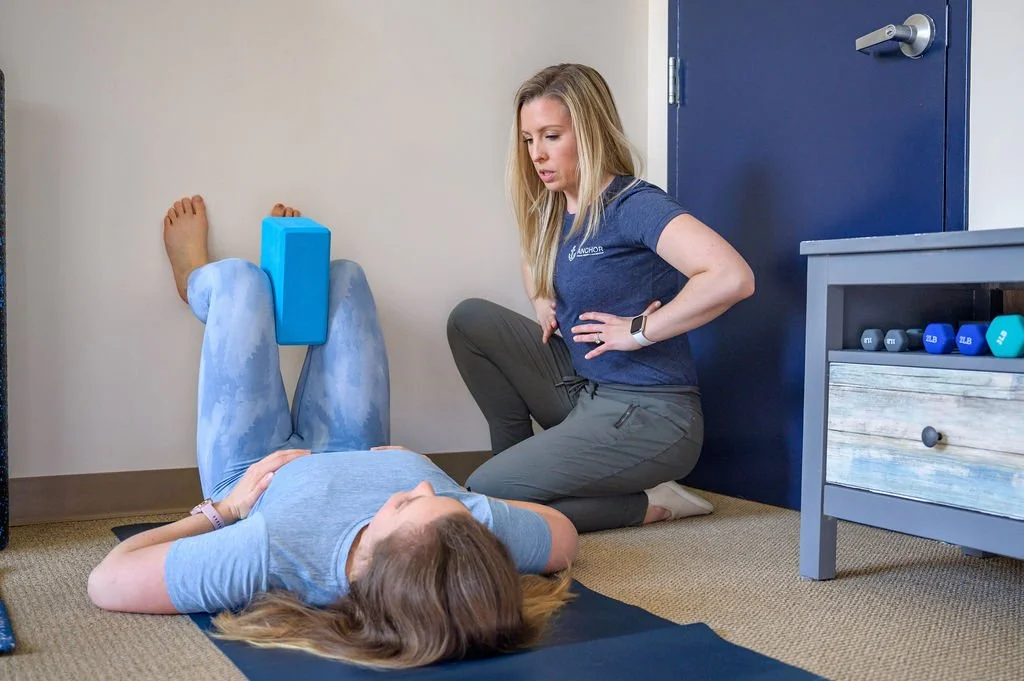Postpartum Incontinence- How Long Does It Last?
Incontinence (or leaking pee) is a common experience postpartum. Leaking even just a few drops of urine is considered urinary incontinence, and it can be improved no matter how long ago you had a baby.
When does incontinence get better?
Some incontinence during pregnancy and postpartum is very common. For some people urinary incontinence will resolve spontaneously as the pelvic floor heals. After a few weeks postpartum you should start to notice symptoms improving.
If you notice symptoms are not improving by 6 weeks postpartum or if you ever notice symptoms getting worse, it is time to reach out for help. The reason behind why you are experiencing incontinence varies depending on the person. With the right assessment and guidance from a pelvic floor physical therapist, you can improve your symptoms and no longer have the fear of leaking.
At Anchor Physical Therapy & Performance we work with active women to help resolve leaking with running, jumping, and sneezing. There is no one-size-fits-all approach to leaking, and it is important to get evaluated to see where the source of your symptoms are coming from. If you live in the Portsmouth, NH area and would like to schedule an appointment with us, fill out a contact form and we would love to chat with you.
What causes postpartum incontinence?
There are countless factors that can impact the body’s healing process and whether or not it needs additional support. Any and all of the following may affect healing time:
Shorter or longer pushing phase during labor and delivery
Emergency or planned c-section
Tearing or need for stitches
Number of pregnancies
Carrying a single baby vs multiples
Complications during delivery
Level of support postpartum
Pre-existing incontinence
Exercise routine during pregnancy
Knowledge of pelvic floor protection strategies during pregnancy and labor
And many more…
Some examples:
If you experienced an uncomplicated pregnancy, standard vaginal delivery with no complications, a shorter pushing phase, and minimal to no tearing, we would anticipate a shorter recovery time
If you experienced complications during pregnancy, a longer pushing phase and significant tearing with more complications during delivery, we would anticipate a longer recovery time
What else contributes to postpartum recovery?
Good understanding of how to engage your pelvic floor and core muscles greatly influences the likelihood of postpartum incontinence.
Pelvic floor awareness and doing the right exercises before conception and/or during pregnancy can also go a long way toward decreasing recovery time. It is much easier to re-connect with those muscles postpartum if you have already put some work in on the front end.
Should You Relax or Strengthen Your Pelvic Floor?
One important strategy that can help with recovery is to learn how to intentionally relax the pelvic floor. This is important both during late pregnancy and postpartum. If you want to learn more about what you should do to prepare for labor, check out our blog, Third Trimester Exercises to Prepare for Labor.
More often than not, the pelvic floor is tight after delivery. This is often a surprise to many people, but we often find that the pelvic floor has tensed in an effort to protect itself after what happens in labor and delivery. The pelvic floor also had to do a lot more work for you during pregnancy, which can also cause trigger points and tension in the pelvic floor.
If the pelvic floor is too tight, it can not work efficiently to help you stop leaking. The pelvic floor needs to be able to contract and lengthen to work properly. When the pelvic floor is always contracted or shortened, it won’t be able to react well when you need it to in order to control leaking.
Pelvic Floor Relaxation Exercises
Adductor Stretch: gently rock back and forth to feel an inner thigh stretch, try 10x each side
Half Happy Baby Stretch: option to have one leg up the wall, hold for 1 min each side
Child’s Pose Stretch with Support: use a small pillow under your low belly, place arms in a comfortable position, focus on breathing down into your low back, hips and pelvic floor, x 8 breaths
What if I had a C-section? Does it matter?
Yes it does!
Even if you had a planned C-section and did not have to do any pushing, the pelvic floor is a main support system for a growing baby throughout the duration of your pregnancy. Normal changes that happen during pregnancy include decreased stability in your joints because of ligament laxity, postural changes, and changes in muscle support as the baby grows.
Another post c-section factor that can impact the pelvic floor and incontinence is the presence of scar tissue. Working on loosening the scar tissue can be very beneficial in helping incontinence symptoms. You can read more about this on our blog, Early C-section Recovery.
Postpartum Pelvic Floor Physical Therapy to Treat Incontinence
At Anchor Physical Therapy & Performance, we look forward to helping you get back to doing what you love without limitations or fear of leaking. If you feel you would benefit from further guidance to address your symptoms, we are here to help.
We can assess if your pelvic floor is weak, tight, or not coordinating well (or a combination of these) and help guide you in the most efficient course of treatment to help your symptoms.
Whether you are a few weeks postpartum or 10+ years postpartum, you can be leak-free!





